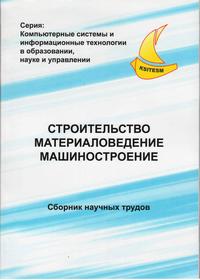Simulation and optimization of oscillatory processes wheeled vehicles in the system of simulation ‘std 3.7’
Keywords:
suspension of wheeled vehicles, optimal design, system of simulation, transient response, phase trajectoryAbstract
Purpose. In the works [1-3] we proved that the dynamic programming for continuous dynamic systems is the efficient method for options of vehicle’s suspension. In existing systems of simulation of dynamic systems this method is not being used. The main advantage of the ‘STD 3.7’ [4] system of simulation is an availability of algorithmic programming language, using which we can create new program models. Our purpose is explain optimization technique of vehicle’s suspension by method of dynamic programming for continuous systems and technology of simulation of oscillatory processes in the ‘STD’ system on the simple example. Technique. Analytical dependences for suspension stiffness and resistance coefficient established therein vibration absorber, which were obtained by the matrix method of dynamic programming based on comparison of the coefficients when displacement and speed in differential equations of free oscillations of synthesized and analogue models. Analytical dependences includes weighting coefficients of quadratic functional of quality, the physical method of which is energy consumption for suppression of harmful vibrations. When selecting the weighting coefficients we proceeded from the main purpose of wheeled vehicle suspension – to provide comfortable environment for passengers. To create a physically realizable suspension that will provide required dynamic properties in a predetermined range of speeds for the wheeled vehicle by introducing additional functional limitations on dynamic parameters. System of simulation ’STD 3.7’ allows you to explore the transitional processes of investigated models and to analyze the stability of oscillatory processes on the phase trajectory. Results. On the simple model of the wheeled vehicle was examined algorithm for selecting optimal parameters of the suspension. The technology of working in the system of simulation ‘STD 3.7’ in the exploring of the transitional process is represented. The resulting transient response shows that the oscillatory process with large amplitudes of displacement of the center of mass of the carcass is occurred in the system. Consequently, the parameters of the suspension are not optimal. Scientific novelty. Methods and means of optimal design of suspension of wheeled vehicles are defined. Practical significance. Outlined tasks of practical application of system of simulation ‘STD 3.7’ in the exploring of the dynamics of wheeled vehicles.References
Ershova N.M. Prikladnoe dinamicheskoe programmirovanie: Monografiya [Applied Dynamic Programming: Monografiya]. Dnepropetrovsk, Pridneprovskaya gosudarstvennaya akademiya stroitelsta i arkhitektury Publ., 2013. 354 p.
Ershova N.M. Optimalnoe proektirovanie sistemy podveshivaniya zheleznodorozhnykh ekipazhey Dokt, Diss [Optimal design of the suspension of railway vehicles. Doct. Diss.]. Moscow, 1989. 346 p.
Ershova N.M., Ershov V.I. Modelirovanie i optimizatsiya kolebatelnykh protsessov kolesnykh mashin: Konspekt lektsiy [Modeling and optimization of processes of vibrationalwheeled vehicles: Lectures]. Dnepropetrovsk, Pridneprovskaya gosudarstvennaya akademiya stroitelsta i arkhitektury Publ., 2001. 148 p.
Kartashov B.A. Sistemy avtomaticheskogo regulirovaniya [Systems of automatic regulation]. Rostov-na-Donu: Feniks Publ., 2015. 458 p.
Fesenko E. G., Ershova N. M. K voprosu razrabotki interfeysa polzovatelya sistemy modelirovaniya «Proyektirovaniye dinamicheskikh sistem» [On the question of the development of the user interface modeling system "Design of dynamic systems"]. Stroitelstvo, materialovedenie, mashinostroenie: sbornik nauchnykh trudov Pridneprovskaya gosudarstvennaya akademiya stroitelsta i arkhitektury [Construction, materials science,mechanical engineering: Proceedings of the Dnieper State Academy of Construction and Architecture], 2014, issue 78, pp. 282-286.
Kotov E.A., Maksimov A.M., Skvortsov L.M. Programmnyy kompleks dlya avtomatizirovannogo issledovaniya i proektirovaniya promyshlennykh robotov [The software package for computer-aided research and design of industrial robots]. Мoscow, Mashinostroenie Publ., 1991. 56 p.
Krutko P.D., Maksimov A.M., Skvortsov L.M. Algoritmy I programmy proektirovaniya avtomaticheskikh system [Algorithms and software design of automatic systems]. Мoskow, Radio i svyaz Publ., 1988. 306 p.
Kozlov O.S., Kondakov D.E., Skvortsov L.M., Khodakovskiy V.V. Instruktsiya polzovatelya programmnym kompleksom “Modelirovanie v tekhnicheskikh ustroystvakh” (PK “MVTU”, versiya 3.6) [Manual software package "Simulation in Technical Devices" (PC "SITD", version 3.6)]. Moscow, Uchebno-nauchnyy tsentr "Nuklon" Publ., 2008. 187 p.
Pupkov K.A., Yegupov N.D. Metody klassicheskoy i sovremennoy teorii avtomaticheskogo upravleniya. [Methods of classic and present theories of automatic management]. Мoscow, Moskovskiy gosudarstvennyy tekhnicheskiy universitet imeni N. E. Baumana Publ., 2004.
Kartashov B.A. Praktikum po avtomatike. Matematicheskoe modelirovanie sistem avtomaticheskogo regulirovaniya [Workshop on automation. Mathematical modeling of the automatic control systems]. Moscow, KolosS Publ., 2006. 184 p.
Pevzner L.D. Praktikum po teorii avtomaticheskogo upravleniya [Workshop on automatic control theory]. Мoscow, Vysshaya shkola Publ., 2006. 590 p.
Downloads
Issue
Section
License
Редакція Видання категорично засуджує прояви плагіату в статтях та вживає всіх можливих заходів для його недопущення. Плагіат розглядається як форма порушення авторських прав і наукової етики.
При виявлені у статті більш ніж 25% запозиченого тексту без відповідних посилань та використання лапок, стаття кваліфікується як така, що містить плагіат. У цьому випадку стаття більше не розглядається редакцією, а автор отримує перше попередження.
Автори, в статтях яких повторно виявлено плагіат, не зможуть публікуватися в усіх журналах Видавництва ДВНЗ «Придніпровська державна академія будівництва та архітектури».
Автори, які публікуються у цьому журналі, погоджуються з наступними умовами:
- Автори залишають за собою право на авторство своєї роботи та передають журналу право першої публікації цієї роботи на умовах ліцензії Creative Commons Attribution License, котра дозволяє іншим особам вільно розповсюджувати опубліковану роботу з обов'язковим посиланням на авторів оригінальної роботи та першу публікацію роботи у цьому журналі.
- Автори мають право укладати самостійні додаткові угоди щодо неексклюзивного розповсюдження роботи у тому вигляді, в якому вона була опублікована цим журналом (наприклад, розміщувати роботу в електронному сховищі установи або публікувати у складі монографії), за умови збереження посилання на першу публікацію роботи у цьому журналі.
- Політика журналу дозволяє і заохочує розміщення авторами в мережі Інтернет (наприклад, у сховищах установ або на особистих веб-сайтах) рукопису роботи, як до подання цього рукопису до редакції, так і під час його редакційного опрацювання, оскільки це сприяє виникненню продуктивної наукової дискусії та позитивно позначається на оперативності та динаміці цитування опублікованої роботи (див. The Effect of Open Access).

